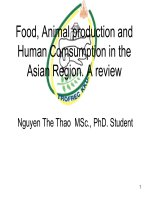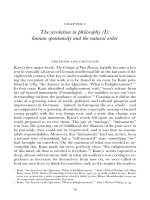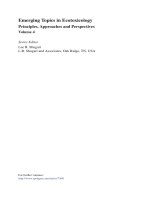Human evolution in the Pleistocene
Bạn đang xem bản rút gọn của tài liệu. Xem và tải ngay bản đầy đủ của tài liệu tại đây (132.57 KB, 8 trang )
1 Human evolution in the Pleistocene
The origins of humanity may be traced to the tropical African Pliocene, around 6
million years ago (Myr). Genetic evidence has for some time predicted the ex-
istence of a common ancestor to chimpanzees and humans around 5–6 Myr
(Takahata & Satta, 1997; Gagneux & Varki, 2001). Recent discoveries of
African fossils that are claimed to be close to this common ancestor have been
dated to between 6 and 7 Myr (Brunet et al., 2002).
From this point until the emergence of Homo erectus 1.9 Myr ago and its
rapid subsequent range expansion (Aguirre & Carbonell, 2001), hominids were
confined to sub-Saharan Africa. The estimated number of species that lived
during this long period in the Pliocene varies among authors. If we follow a
conservative approach (Klein, 1999) we observe a pattern of increasing hominid
species richness from about 4.6 Myr with a peak between 1.9 and 1.6 Myr and
a sharp decline thereafter (Fig. 1.1). The decline after 2 Myr ago is correlated
with increasing climate instability.
The peak in diversity coincides with the first appearance in the fossil record
of H. erectus. Recently this early African member of the genus Homo has been
separated from contemporary Asian forms. The name H. erectus has been re-
tained for the Asian forms and the name H. ergaster for the African (Klein,
1999). Recent evidence suggests, however, that the two significantly overlap in
morphology and that they should form part of a geographically diverse species
H. erectus (Asfaw et al., 2002). I follow this latter classification here. Subse-
quent forms have been given specific status by different authorities although
there is considerable uncertainty regarding the precise boundaries of each. The
classification of fossils is fraught with difficulties as we shall see in Chapter 4.
In this book I consider H. erectus–H. sapiens to be a single chronospecies
(Cain, 1971) that has repeatedly produced divergent lineages through geo-
graphical isolation during the last 1.9 Myr. Some of the described forms are
clearly temporal entities within the H. erectus–H. sapiens continuum. I include
H. heidelbergensis and H. helmei in this category. Others are divergent lin-
eages that have subsequently become extinct. The Neanderthals are the clearest
example of such a divergent lineage and their relationship with mainstream
H. sapiens will occupy much of this book. Until equivalent fossils are found
in Africa it is probably best to regard the form H. antecessor from the Spanish
site of Atapuerca (Carbonell et al., 1995), and possibly also those of Ceprano
1
2 Neanderthals and Modern Humans
in Italy (Manzi et al., 2001) in this latter category, i.e. a divergent lineage that
became extinct.
The question of interbreeding between mainstream H. sapiens and diver-
gent lineages when geographical or ecological barriers broke down will be ad-
dressed, with specific reference to Neanderthals and contemporary mainstream
H. sapiens, in Chapter 7. The degree of genetic isolation of the constituent pop-
ulations would be dependent on a range of factors at any point. These would
include distance effects and physical, climatic and ecological barriers. Popu-
lations would become isolated at some points and a process of genetic diver-
gence would ensue. Most often such a process would end with renewed contact
among populations. At other scales, metapopulations in different regions would
become isolated from each other. Gene flow would continue within but not be-
tween regions. At even larger spatial scales entire regions would occasionally
Time (Myr)
0-1-2-3-4-5
Number of Species
5
4
3
2
1
0
Observed
Cubic Model
(a)
Figure 1.1. (a) Number of hominid species during the last 5 Myr using a conservative
number of species. A cubic model best fits the observed pattern: y = 0.2328 −
2.5022x − 0.9973x
2
− 0.1059x
3
;R
2
= 0.293; P = 0.002. (b) Decline in hominid
species in the last 2 Myr. A cubic model best fits the pattern: y = 0.8187 − 2.5122x −
5.6201x
2
− 3.1246x
3
;R
2
= 0.923; P < 0.0001. (c) Relationship between number of
hominid species and climate variability (coefficient of variation of temperature) in the
last 2 Myr. The pattern is best described by a quadratic model: y = 10.9797 − 1.9269x
+ 0.914x
2
;R
2
= 0.366; P = 0.033.
Human evolution in the Pleistocene 3
Time (Myr)
0.0-.5-1.0-1.5-2.0
Number of Species
5.0
4.0
3.0
2.0
1.0
0.0
Observed
Cubic
(b)
Climate Variability
131211109876
Number of Species
5.0
4.0
3.0
2.0
1.0
0.0
Observed
Quadratic
(c)
Figure 1.1. (cont.)
4 Neanderthals and Modern Humans
become isolated from others. I have introduced scale here and it is an issue that
is central to understanding ecology (Levin, 1992) and will appear frequently in
this book. In this case we can see how small-scale population isolation events
would be expected to be frequent relative to regional events involving many
populations.
Populations most distant from each other would be expected to be genetically
most distinct but linked to each other by intermediate forms. Where isolation
of extreme populations was long, populations at the extremes of the range may
have diverged to the extent that they subsequently behaved as good species.
In the case of Pleistocene Homo, geographical comparisons have to be made
among contemporary forms. As we are studying phenomena through time, it
is also important that geographical patterns from different time periods are
not merged. It is common, for example, to find generalised distribution maps
of Neanderthal geographical range in the literature (e.g. Stringer & Gamble,
1993). These should only be regarded as maps of the extremes of the range
reached according to currently available evidence. In reality the Neanderthal
range, as that of other forms of Homo and indeed all other animals, shifted,
expanded and contracted through time and it is these range changes that are
likely to be most informative about Neanderthal behaviour, as we shall see in
Chapter 3 (Fig. 1.2). If we follow this approach, bearing in mind the limitations
of the available data, we observe a changing pattern of global distribution of
Homo in the Pleistocene.
There are two apparently contrasting models that, as we shall see in this
book, are in effect extremes of a continuum. Much of the debate that has raged
in the last two decades in this respect has been due to differences in the under-
standing of the evolutionary process and confusion with taxonomic techniques,
particularly cladistics. I will start with a brief statement of the two contrasting
models.
On the one hand, we have the multiregional model that has been championed
by Wolpoff and his school (Wolpoff, 1989). According to this model H. erectus–
H. sapiens is a single species (hence H. sapiens). The variations that are observed
among fossils simply reflect natural variation as the species has evolved through
time. As populations became isolated, so geographical variations arose between
them just as they do in most widely distributed organisms. According to this
model and its variants, genetic barriers between the populations were never
severe enough to cause speciation. Thus present-day human populations reflect
a combination of regional variation that dates back to the earliest colonisations
and relatively continuous gene flow among the populations. The intensity and
frequency of gene flow would be greatest among neighbouring populations and
lowest among those geographically most distant.
Human evolution in the Pleistocene 5
Figure 1.2. Maximum limits (grey area) of the Neanderthal geographical range in
Europe and western and central Asia. Bioclimate boundaries as in Figure 5.3.
On the other hand, we have the ‘Out-of-Africa 2’ model that has been asso-
ciated most strongly with Stringer (Stringer & Andrews, 1988). According to
this model all natural variation that existed among populations of Homo was
removed very rapidly after 100 000 years (kyr) ago by the geographical expan-
sion of ‘Modern Humans’ that evolved somewhere in eastern or north-eastern
Africa. As these ‘Modern Humans’ spread out of Africa they replaced all exist-
ing populations of Homo across Africa and Eurasia. These ‘Archaic’ African and
Eurasian populations had evolved regionally after an earlier ‘Out-of-Africa 1’
expansion of H. ergaster around 1.9–1.8 Myr ago. The model, in its current
form, does not negate the possibility of interbreeding among ‘Modern’ and
‘Archaic’ forms on contact but it does assume that no ‘Archaic’ genes persisted
into present-day populations.
These ideas may seem very different and irreconcilable but in reality this is
not the case. To a large extent the two views reflect a different understanding of
the evolutionary process. The multiregional model follows the neo-Darwinian
school that sees evolution proceeding through small, cumulative, changes within









